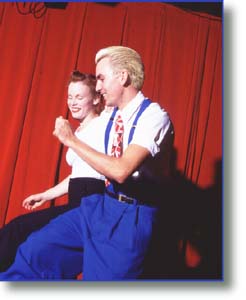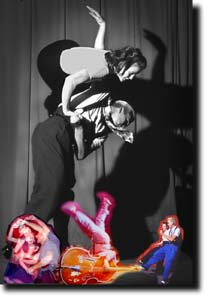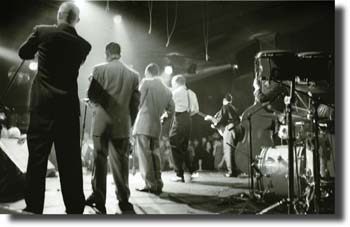Swing Is on an Upswing
With the Swing revival, can a generation of slackers learn to dance?
By Richard Sine
THE MEN COME in suspenders, fedoras and high-waisted pants, or in full zoot suits, their hair frozen in pompadours. When the music gets going, they strip to shirtsleeves or undershirts. The women dress in plaid skirts and bobby socks, their hair sprayed into a rat. The music is subtle and improvisational; the lyrics are funny or gently melancholic; the dancing is exuberant and practiced. You can actually hear what your friends are saying.
After an hour on the floor, Angelle and I are doing all right. Of course we can't touch Johnnie Swing, the dance instructor who's working the Lindy in an electric-blue zoot suit and a pair of two-tone spats. And we certainly don't compare to Claudia and Joann Ribalta, who are flipping and lifting each other in a freestyle city swing, energized by Royal Crown Revue's rendition of "Walk Right In."
Angelle and I didn't dress the part. But I'm leading her through eight kinds of spin and a foot trick, and despite the fact that Angelle has never danced swing before, we're having fun.
Here on the edge of the floor we're nearly surrounded by young men in golf shirts, racing-stripe shirts and assorted piercings. Their arms are folded across their chests, hands gripping Pale Ales. They're perfectly still, like frickin' Stonehenge, I'm thinking. Here we are now, entertain us. A couple of them absent-mindedly step on Angelle's feet, and for a moment she gets self-conscious. "I'm a little embarrassed," she says. "It's like everyone is standing around and watching us."
A few of them probably are, but I don't care. A dancing couple, almost regardless of skill, creates a consecrated space--an energetic aura, like those science exhibits where you pump a foot pedal to turn on a headlamp. When I look across the club, I realize that many people here tonight just don't get it, not yet. "You know, it doesn't matter," I try to reassure her. "We're dancing, and they're not. They just don't know what they're missing."
DANCING IS THE third dimension of music. Many people say they love music but don't dance, which is like closing one eye and insisting your sight is still just fine. And unfortunately, so many people in my generation--Generation X--are one-eyed Jacks. When it comes to dancing, we are scared, puzzled, aimless. The children of Boomers, we are a full generation removed from the time when people actually danced in a partner's arms, to practiced and rhythmic steps.
Of course, in clubs throughout America musicians are playing music that swings, rocks, slams and funks. But the onlookers stand there stock still, like they're auditing an economics lecture. Often, the bass seems to shake the floorboards so hard that only a set jaw and locked knees can anchor them down. This rooted stance generates a sort of poison--a sour, ossifying acid in the bloodstream--that only dancing can dilute.
At the clubs with the hard-core rock bands, "dancing" is confined to a violent mosh pit where many women (and men) fear to tread. Except for moshing, skanking, pogo-ing and head-bobbing, actual dancing to an actual band is rare. Dancing for dancing's sake has been banished to "dance clubs" or DJ nights, where there is no band, only deafening, monolithic speaker stacks as likely to inspire genuflection as dancing.
There is also a phenomenon at many of the dance clubs, where nobody appears to really dance with anyone else. Instead, clusters of friends stand in moderate proximity, their bodies rigid, heads nodding to the beat. Occasionally their eyes scan the dance floor, scoping the scene and waiting for something to happen.
There appear to be no such thing as "steps" anymore. But you've got to do something, so those who might have some facility with dancing make up two or three faux steps which they repeat over and over again.
The girls are most willing to dress up, cut loose and have fun. Many guys won't dance at all unless a female partner can convince them. Then they shuffle onto the floor and labor reluctantly, like engines on a midwinter morning, pumping their arms and clenching their fists. They watch the girls, and hope nobody is watching them.
Of course, among consenting partners, groping and grinding for hours at a time remains an ever-popular dance. (Talk about creating a consecrated space.) But it's hard to blame the dancers--no one has taught them differently. For a generation, maybe two, partners dancing has gone the way of the whitewall tire.
This may soon change. The return of swing dancing, depicted in the L.A.based movie Swingers, already has blossomed in San Francisco and currently is seeping its way down the Peninsula, with nights in the South Bay and in Santa Cruz. The music, born of a generation seeking fantasy and escape, is campy and fun. Stories in national magazines have dwelled upon the current vogue for 1940s paraphernalia: martinis, cigars, golf clubs. To me, however, the most exciting thing about this era of retro is the possibility that it will teach more members of a danceless generation to dance. And dancing is a blast.
Swingin' in Santa Cruz.
WHEN I STARTED DJing at my college radio station, Nirvana was a daring, unknown band. By the time I graduated, Kurt Cobain was adored by every teenager in the nation (and he was still miserable). A few weeks after graduation, I found a Peggy Lee CD in my father's collection and spun a song called "I'm Beginning to See the Light." It was smooth, catchy, and it had a beat different from anything I'd heard before. My father was shocked that I enjoyed it, particularly since it came from an era before his own time. But to me, it was utterly new.
Swing is the anti-grunge.
Richard Powers, a dance teacher and dance historian at Stanford University, speculates that in the latter half of this century, many kids have taken a shine to their grandparents' music. Swing is a form of rebellion, because it's the kind of music their parents really hated--all that cheesy cha-cha music, all that "Tin Pan Alley drool," as one Baby Boomer put it.
Historians note that the Baby Boomers pretty much stopped couple dancing in the early 1960s, about the time a Philadelphian named Chubby Checker released a record called "The Twist." The Twist was the first of many dances that excluded contact between the sexes.
At the time, the development probably wasn't surprising. Swing dancing already had incorporated "breakaway" moves in which each partner improvised individual steps. The kids were watching the new rock & roll idols dance solo on the TV screen, and they were dancing solo in their seats. Perhaps it was only a matter of time before they danced solo on the floor.
Photo by Christopher Gardner
SOME COMMENTATORS have said the new solo dancers were expressing a freedom from the old-fashioned sex roles expressed in couple dancing, where the male almost always "leads." Whatever the reason, dancing was never the same after couple dancing died. You can see the difference at the clubs.
"Solo dancing involves showing off to a partner," says Stanford's Powers. "You are the center, and you're trying to impress, sort of like birds who dance around each other and puff out their chests in a mating dance. In partner dancing and in swing, the dynamic is totally different. You're not showing off. The best dancers don't show off, and don't like it when their partners do it."
Powers pauses thoughtfully. "You know, I've hung out with dancers after a dance, and they'll say: Have you noticed the best lovers are the best dancers? Meaning they're not showoffs, they're not in it just for their own gratification. The best dancers are the ones who are the most attentive, the ones who exist for their partners. You simply can't do that in solo dancing, where your partner, if you can call it that, is four feet away."
Solo dancing, then--enjoyable as it may sometimes be--is an outgrowth of what Christopher Lasch called the Culture of Narcissism. Think of American Bandstand or MTV's The Grind, television shows in which much of the dancing is exhibitionism aimed at attracting the camera's eye.
If anything, current trends in popular music are only bringing society farther away from the pleasures of couple dancing. To alternative rockers, couple dancing makes no sense at all. Most graceful couple dances are little dramas of seduction, separation and joyful consummation; most alternative rock songs are moody tales of hate, desperation or sado-masochism. Powers and many other dance instructors teach people to swing to Smashing Pumpkins and Pearl Jam, but I'm a little skeptical of that trend. The beat is too simple and too hard. More importantly, the drama is all wrong.
East Coast Swing, as it is generally known, is easy to learn: It's hard to botch a sway and a twirl. And once you get started, all that self-righteous alienation, all that cynicism that sticks like Krazy Glue, starts sloughing right off.
FOR MANGO AND Dana, it really started with the clothes. "It's not like we knew the clothes came from a particular era," Mango Holzem recalls. "It's just that we knew what we liked. And we weren't into the mainstream kind of thing."
Today Mango wears a green cardigan, black penny loafers, white open-necked shirt and white socks. During our conversation, she fiddles with a leopard skin muff. Her roommate and dance instruction partner, Dana Sornstein, looks just like "Rosie the Riveter" in a pink sweater, rolled-up jeans and red bandanna.
The living room in their Sunset District flat mimics a Tiki bachelor pad. The couch, chairs and wet bar are all bamboo. There's a Bettie Page pin-up book on the bamboo coffee table, a wooden 1946 Emerson TV set that looks like it could withstand an A-bomb, and lurid dime-store paperbacks on the mantelpiece. Bing Crosby croons on the radio. "Nothing in this house was more than $50," Dana says pridefully, and she doesn't mean adjusted for inflation.
"We started out dancing just by flipping each other around the living room," says Mango, who is 25 just like her friend. "Then we discovered the Club Deluxe on Haight Street. It was Saturday night and it was empty--it's never like that anymore."
"We saw St. Vitus Dance there," Dana adds, "and when the singer, Vise Grip, saw us, he told us wherever we went, we could get a free ticket in. That's what started it. We'd come down from Santa Rosa in a Chrysler New Yorker four nights a week."
I asked Dana where she got her moves. "We didn't have any dancing background, so we made stuff up," she says. "We watched old movies, documentaries about Cab Calloway and Frankie Manning."
Dana hands me a list of the moves she teaches: the Pretzel, the Cinderelli, the Grease Move, Midgets Wrapped in Leather. The folks at the old Savoy in Harlem wouldn't recognize the names. But the moves look authentic enough that when Mango and Dana take the floor at the Claremont Hotel in Berkeley, grandmothers in attendance have been known to shed a nostalgic tear. "All I want," says Dana, "is to be airborne at all times."
Looking Back: Bands like the Royal Crown Revue recapture the glamorous past.
THE SWING SCENE has gotten so big over the past couple of years, packing the dance floors on swing nights, that it is often difficult for Dana to get airborne even some of the time. A recent article about swing in the San Francisco Bay Guardian reported complaints that the swing scene has become exclusive, as some San Francisco scenesters have become obsessed with accurate period dress and dancing ability. Mango and Dana certainly spend a lot of time on both their dance technique and their dress. But they say the attitude of the swing scene is just as important to them.
"Everybody is so much more sophisticated and kind and polite to each other," Dana says. "Men pull out your chair, open your doors and light your cigarettes. We're so used to the skaters and the grunge kids and their keggers. I think it's neat."
The better part of Generation X swing dancers and musicians have histories in the punk and grunge scene. Claudia Ribalta came to The Usual in a Navy retro dress with a slit in the back displaying her baroque tattoo. She and her husband, Joann, have placed in rockabilly dance contests. "I used to be into punk rock, and it was so full of negative energy," she reports. "Then I got into a relationship, and couple dancing brings us closer together. It's a little more romantic and elegant. You get the feeling people had more class back then."
I NEVER DANCED as a teenager, mostly because I didn't feel popular enough to allow myself to cut loose. Couple dancing was totally out of the question. When the slow songs came on at the junior high dance, the popular boys and girls would hang on each other and sway back and forth as if trapped in a freezing blizzard.
I used to think that partner dancing happened only in old movies, or on Love Boat episodes, as a prelude to sex. Then I started going to weddings and jazz clubs and was shocked to see the most average-looking, middle-aged couples create magic on the parquet. In college I got comfortable with dancing to house music, and soon after graduation I started taking couple dance classes.
In most ballroom classes the men rotate partners every few minutes. This is supposed to acclimate you to an evening where you may dance with several people in a night, many of whom may be strangers. For the enlightenment of my fellow slackers out there, this is supposed to happen regardless of whether you're attracted to your new partners. The function of dancing at a ballroom or a swing club is to enjoy dancing. The function of dancing at a disco seems to be watching a "partner" rhythmically move across the dance floor to determine whether it would be enjoyable to see a similar dance performed horizontally.
I'VE FOUND THAT every dance class has a cast of characters. There's the older lady whose turquoise-lined eyes never wavered from mine while we were dancing, her spiky eyelashes never blinking; the willowy blond who swayed from side to side like a sapling; the schoolteacher who would place my hands properly whether I was dancing with her or another partner; the gray-haired lady who abashedly dropped in a little Lindy style when she was having a good time; the big-boned lady who gallumphed from side to side as if at a square dance. I would leave the class smelling of three kinds of perfume.
I took my last set of classes over the hill at Sunnyvale's Starlite Ballroom, which advertises itself as the U.S.'s largest dance studio. The Starlite teaches all kinds of social dancing in the evenings, and then holds massive dance parties on the weekends. However, I was a little disappointed to learn that the East Coast Swing taught there was somewhat different than the swing danced at clubs. When I asked one Starlite swing instructor about this, he confessed he'd never been to the clubs. (See the sidebar for where to learn club-style swing.)
The Starlite Ballroom, a very comfortable smoke- and alcohol-free place to dance, feels insulated and about as romantic as a high school gymnasium. But bands do not play there. It falls short of the swing ideal, where bands and dancers literally riff off each other's moves, where you can hear the "big" in big band.
Whether a dancer learns the exact style and wears the exact same clothes as all the swing pros is not the point. Those concerns will just slow a beginner down. The point is learning enough to be able to go to a swinging club and do something invigorating and non-traditional, something besides "standing around complaining about your life," as my friend Angelle wryly puts it. Everybody does that, and it's lost whatever rebellious charm it once had. Nowadays, when anyone hits the dance floor for a spin and a dip, it kills all the clichés.
[ Santa Cruz | MetroActive Central | Archives ]
This page was designed and created by the Boulevards team.

Photo by Christopher Gardner![[line]](/gifs/line.gif)
![[line]](/gifs/line.gif)

Swing fan Cari Siess takes flight with the help of partner John Boulland.
Christopher Gardner
From the December 19-25, 1996 issue of Metro Santa Cruz
Copyright © 1996 Metro Publishing, Inc.
![[MetroActive Arts]](/arts/gifs/art468.gif)